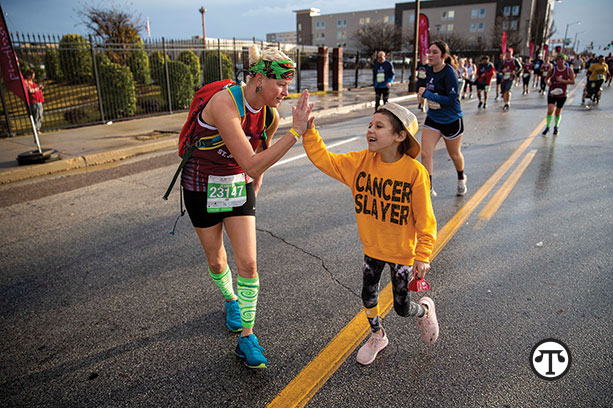
(NAPSI)—Amid thousands of other runners at the St. Jude Memphis Marathon, James Eversull was determined to build on his story, though he has no memory of it.
It began in 1964, when Eversull, all of a year and a half old, became a patient at St. Jude Children’s Research Hospital, which had opened just two years earlier. Diagnosed with acute lymphoblastic leukemia—a virtual death sentence back then with a survival rate of only 4 percent—he was part of a group receiving a treatment regimen involving chemotherapy and radiation.
“They gave it to five of us, and I was the only survivor,” said the now-55-year-old Texan, who cites the experience as a reason for running the full marathon benefiting St. Jude. “Anything I can do to help kids is something I want to do. God saved me for a reason.”
While Eversull was among the oldest St. Jude survivors running, 8-year-olds Kinlee Johnson and Alexander Bolding are new to their journey. They became best friends a year ago while undergoing treatment for medulloblastoma, a type of brain tumor.
“We’re so excited to be part of this,” Kinlee’s mom, Nicole Johnson, said. “St. Jude has been the biggest blessing for me, because they saved my daughter’s life.”
“They’re a package deal,” Alexander’s mom, Jillian Bolding, said. Because they used wheelchairs part of the way on the 5K, the two youngsters were the first participants out on the course. Diagnosed last November, Kinlee underwent 30 rounds of proton therapy at St. Jude, which has the world’s only proton therapy center dedicated just to children, and four months of chemo to treat her brain tumor. Like Alexander, she’s finished treatment but is struggling to get stronger.
“I’m bringing her wheelchair, but she’s going to walk as much as her little heart will let her,” Kinlee’s mom said. “She still has a long road ahead of her.”
Along that road, she’ll find Eversull, who came to St. Jude decades earlier and completed his fifth marathon.
Long after his treatment ended, Eversull became one of the first to sign up for the St. Jude LIFE Study, which tracks the health of childhood cancer survivors to help them deal with further problems and provides researchers insight into the late effects of treatment.
“It’s good to help other kids,” he said.
Among the record 26,000 runners, nearly 1,000 entrants were St. Jude patients or family members and friends. Many wore an armband—yellow for those in treatment or survivors and purple to honor deceased patients.
The involvement of patients and their families is one of the distinguishing components of the annual St. Jude race. Another is the jaunt that runners take through the hospital’s 65-acre campus, where staff, caregivers and patients, many of them in wheelchairs, line the course waving pom-poms and signs and ringing cowbells.
The race is the largest single-day fund-raiser for St. Jude, generating some $11.2 million. The money helps St. Jude treat children with cancer and other catastrophic childhood diseases for which families never receive a bill for treatment, travel, housing or food, and it supports research that has helped boost survival rates for childhood cancer from 20 percent when St. Jude opened in 1962 to 80 percent today.
This year’s participants came from 45 states and six countries. Some 6,500 were “St. Jude Heroes,” meaning they raised money on their own for the race.
- Tom Charlier is a writer for ALSAC, the fund-raising and awareness organization for St. Jude Children’s Research Hospital. He previously worked as a journalist in Memphis for more than 25 years.
““Anything I can do to help kids is something I want to do. God saved me for a reason,” said James Eversull, a childhood cancer survivor thanks to St. Jude. http://bit.ly/2RWiC3X”
